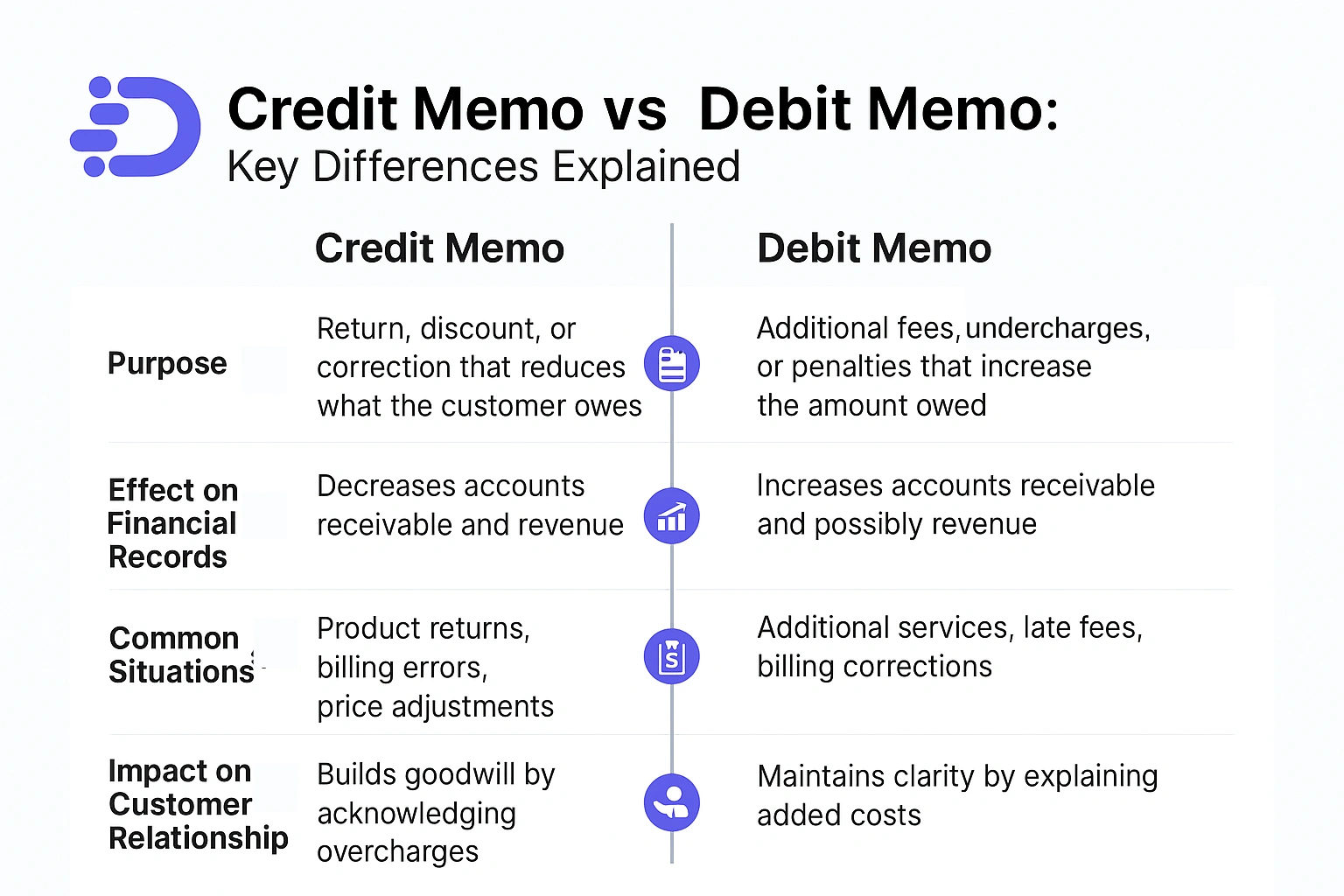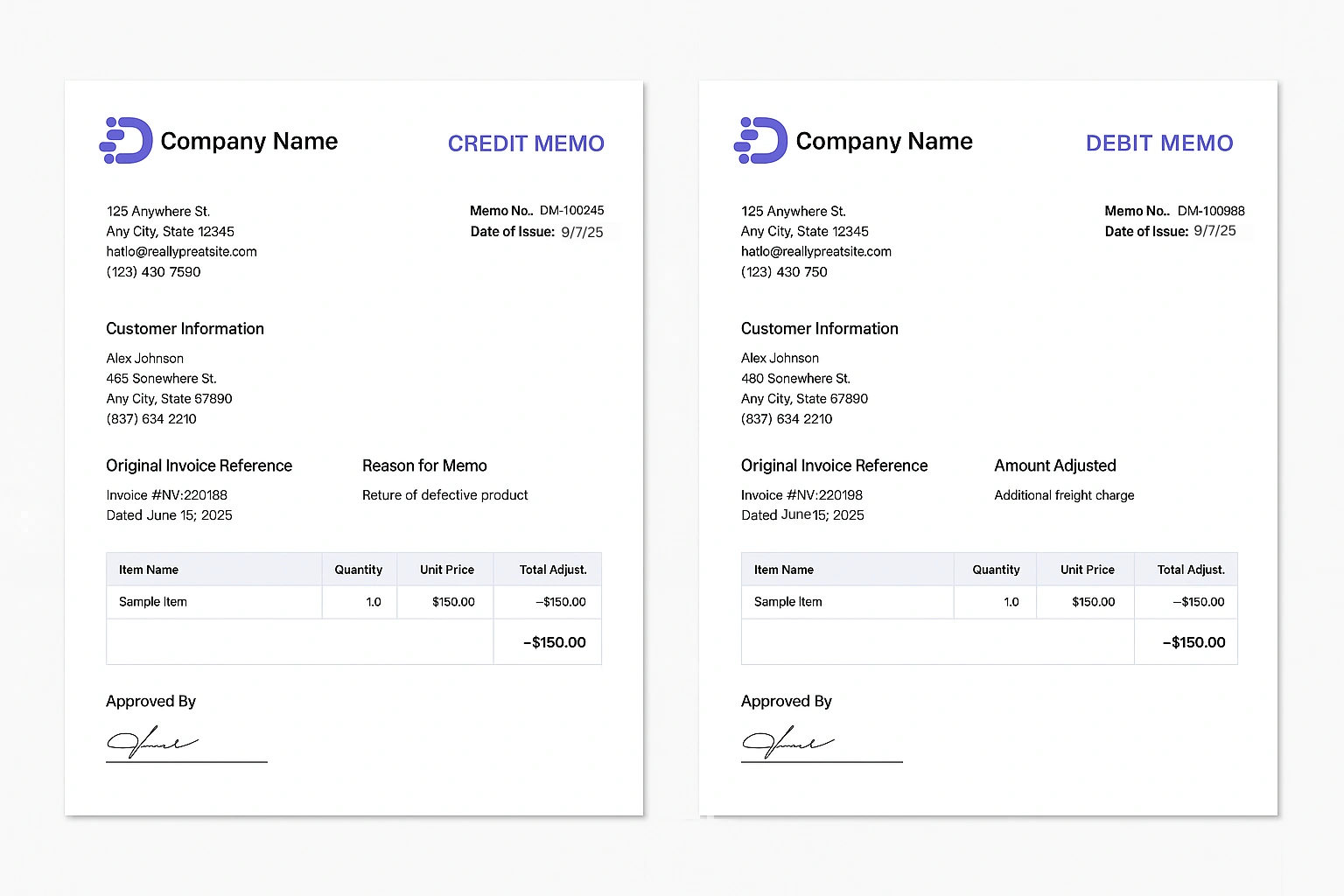A credit memo and a debit memo are important financial documents used in business transactions to adjust invoices. A credit memo reduces the amount a customer owes, often due to returns or billing errors, while a debit memo increases the amount owed, usually for additional charges or corrections.
A credit memo, or credit memorandum, is an official document issued by a seller to a buyer that serves to reduce the amount the buyer owes on a previously issued invoice. This adjustment can happen for several reasons, such as when a customer returns goods, when there was an error in the original billing, or when the seller wants to provide a discount or refund.
For example, if a product was damaged or the wrong item was shipped, the seller can issue a credit memo to correct the invoice amount without creating a new invoice. Credit memos play a vital role in maintaining accurate financial records, as they ensure that the accounts receivable reflect the true amount due.
Businesses issue credit memos for several important reasons to correct or adjust previously billed amounts, and to ensure accurate financial records and strong customer relationships. Common reasons include:
A debit memo, or debit memorandum, is a financial document issued by a seller or service provider to a buyer that increases the amount owed on a previously issued invoice. Unlike a credit memo, which reduces the balance, a debit memo serves to add charges to a customer’s account.
This adjustment can occur for several reasons, such as when additional services are provided after the original invoice was sent, when there was an underbilling or pricing error, or when penalties and fees need to be applied.
For example, if a customer consumes extra products beyond the original agreement or if interest on late payments needs to be charged, a debit memo formalizes these changes without requiring the creation of a new invoice.
Debit memos help in maintaining accurate accounting records, ensuring that businesses collect the correct amount due, and providing clear communication to customers about any additional charges.
Businesses issue debit memos to increase the amount a customer owes on a previously issued invoice, helping to ensure accurate billing and proper revenue management. Common reasons for issuing debit memos include:
A debit memo is used to raise the amount a customer owes, often due to additional fees, corrections, or previously undercharged amounts. In contrast, a credit memo lowers the amount owed, typically because of product returns, discounts, or billing mistakes. These documents adjust financial records but work in opposite directions.
Although these terms are frequently used, distinguishing between debit memos and credit memos can sometimes be tricky, especially in accounting and reconciliation processes. Let’s explore their main differences:
A debit memo is sent by a company to inform a customer that their outstanding balance has increased. This can occur when extra services or products are added, errors need correction, or late fees are applied.
Conversely, a credit memo indicates a reduction in the customer’s balance, often issued when goods are returned, billing favors the customer, or price adjustments are made.
Debit memos increase the accounts receivable amount, reflecting that the customer owes more. Depending on the situation, it might also boost the company’s revenue.
Credit memos, on the other hand, reduce accounts receivable and decrease the amount the customer is required to pay.
Debit memos arise from additional charges, corrections for underbilling, or penalties that increase the amount due.
Credit memos are created to acknowledge returns, refunds, or discounts that decrease the invoice total.
Issuing debit memos helps maintain clear communication, as it explains why extra charges are necessary, which supports trust and transparency.
Issuing credit memos reflects the company’s fairness and focus on customer satisfaction, as it adjusts bills to address returns or overpayments.

Credit and debit memos help maintain accurate financial records and ensure smooth transaction management. With these memos, companies can make necessary adjustments to invoices without creating new ones, which simplifies accounting and improves efficiency. Additionally, credit and debit memos foster transparency and clear communication with customers, reducing the risk of misunderstandings or payment disputes. Here are the most imprtant reasons why credit and debit memos are important in business:
Credit and debit memos are official documents that adjust the amounts on previously issued invoices, and to be effective, they must include several components. These elements ensure clarity, accuracy, and proper record-keeping for both the business and the customer. Including all key details helps avoid confusion and supports smooth financial and accounting processes. Here are the main components that both credit and debit memos typically contain:
Including these components ensures that credit and debit memos serve as clear, professional documents that facilitate accurate accounting and transparent communication between businesses and their customers.
Credit Memo Number: CM-2025-001
Date: July 3, 2025
Customer: John Smith
Customer Address: 123 Main Street, Cityville
Original Invoice Number: INV-10045
Original Invoice Date: June 20, 2025
Reason for Credit Memo: Returned defective product
Description: 1 x Wireless Headphones (Model X123) – Returned due to malfunction
Amount Credited: $120.00
Authorized by: Jane Doe, Sales Manager
Debit Memo Number: DM-2025-001
Date: July 3, 2025
Customer: John Smith
Customer Address: 123 Main Street, Cityville
Original Invoice Number: INV-10045
Original Invoice Date: June 20, 2025
Reason for Debit Memo: Additional services rendered after invoice issuance
Description: 2 hours of technical support beyond contracted agreement
Amount Debited: $150.00
Authorized by: Jane Doe, Service Manager
These templates include all key components and clearly explain the purpose of the adjustment. If you want, I can help you customize these templates for specific industries or software formats!

Efficiently managing credit and debit memos helps in maintaining accurate financial records and fostering strong customer relationships. DepositFix offers robust tools to streamline the creation and management of these documents, ensuring accuracy and professionalism in your billing processes.
DepositFix's Credit Memo Template is designed to simplify the process of issuing credit memos, providing a user-friendly interface with several key features:
DepositFix's Debit Note Tool is designed to streamline your billing adjustments, offering a range of features to enhance efficiency:
With DepositFix, you can ensure accurate, efficient, and professional handling of billing adjustments, ultimately enhancing financial management and customer satisfaction.
Credit and debit memos play a role in correcting billing errors, handling returns or additional charges, and ensuring transparency in all transactions.
With well-structured credit and debit memos, companies can streamline their accounting processes and avoid costly payment disputes. Tools like DepositFix further enhance this process, as they offer automated, easy-to-use templates that simplify memo creation, reduce errors, and save valuable time. Integrating such solutions into your business not only improves billing accuracy but also supports better cash flow management and fosters trust with your clients.
Discover the hidden automation in your payment, billing and invoicing workflows. Talk to our experts for a free assement!
